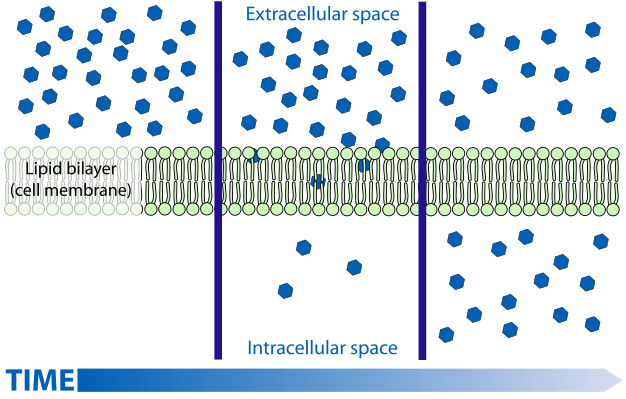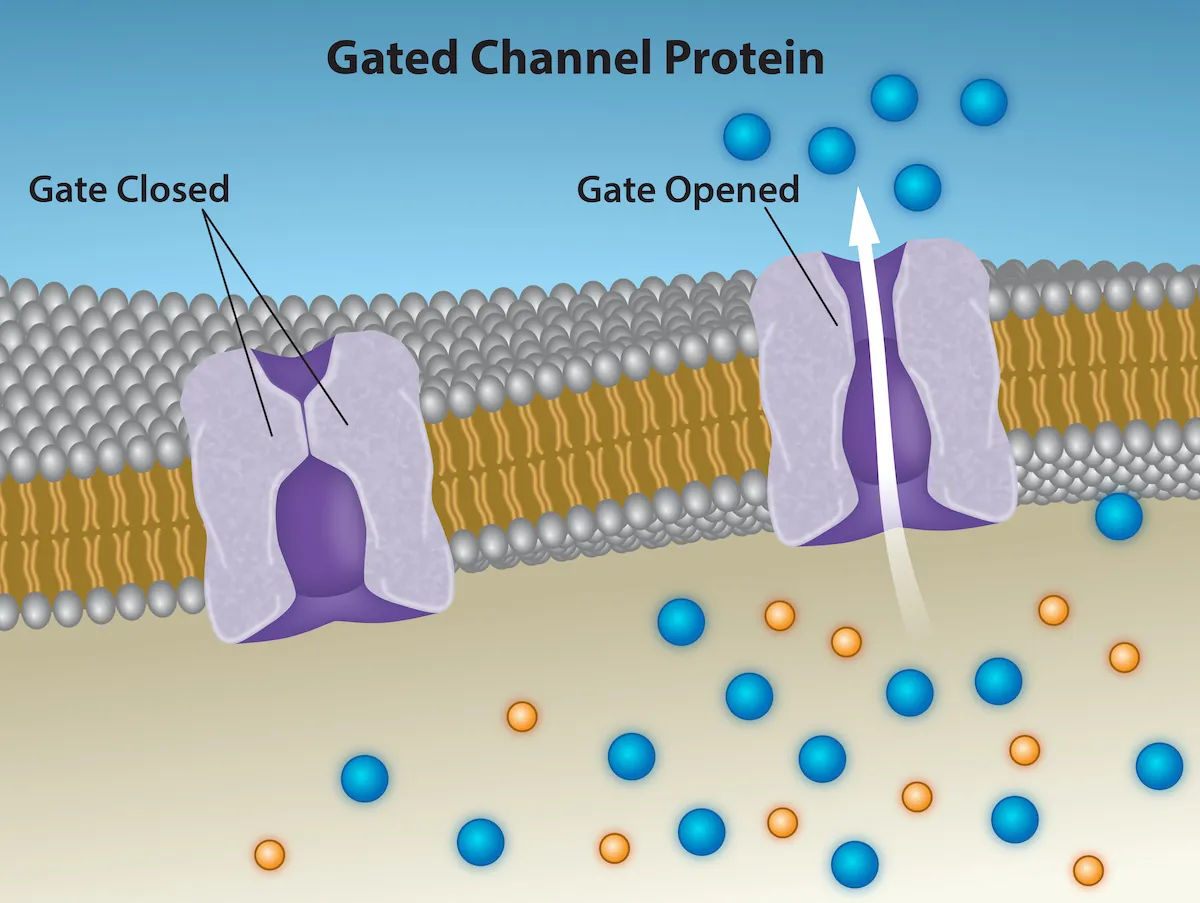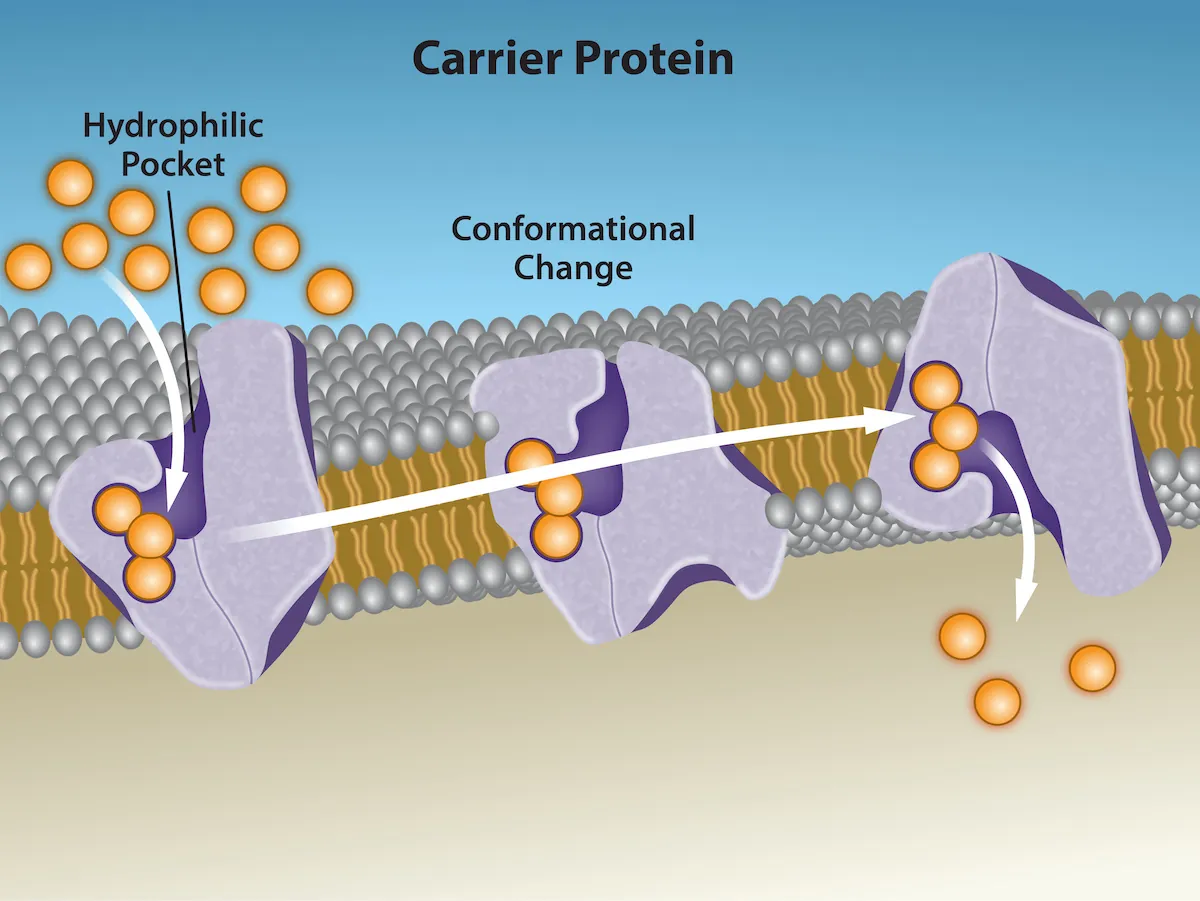OCR Specification focus:
‘Explain diffusion and facilitated diffusion as passive transport mechanisms across membranes.’
Passive transport across membranes enables essential substances to move in and out of cells without requiring energy from ATP. It relies entirely on the kinetic energy of particles and occurs down a concentration gradient, from regions of high concentration to regions of low concentration. This process maintains homeostasis and allows gases, nutrients, and waste materials to move efficiently within living systems.
Diffusion and the Movement of Molecules
Diffusion is the fundamental passive transport process, occurring in both gases and liquids. It is driven by the random movement of particles and results in the net movement from an area of higher to lower concentration until equilibrium is reached.
Diffusion: The net movement of molecules or ions from a region of higher concentration to a region of lower concentration down a concentration gradient, without the input of metabolic energy.
The rate of diffusion is influenced by several key factors:
Temperature – higher temperature increases kinetic energy and rate of diffusion.
Concentration gradient – a steeper gradient increases the net rate of movement.
Diffusion distance – shorter distances allow faster diffusion.
Surface area – larger membrane surfaces enable greater rates of diffusion.
Size and nature of molecules – smaller, non-polar molecules such as oxygen (O₂) and carbon dioxide (CO₂) diffuse more easily than large or polar ones.
Cell membranes play a vital role in regulating diffusion. The phospholipid bilayer is selectively permeable, allowing small, non-polar molecules to move freely, while restricting larger or charged substances.

Simple diffusion through a phospholipid bilayer. Small non-polar molecules (e.g. O₂, CO₂) pass between lipid tails down their concentration gradient without metabolic energy. Labels focus solely on the gradient and bilayer, keeping the mechanism clear and syllabus-aligned. Source.
The Phospholipid Bilayer and Selective Permeability
The cell surface membrane follows the fluid mosaic model, composed of a flexible layer of phospholipids, interspersed with proteins, cholesterol, and carbohydrates. The bilayer’s hydrophobic interior acts as a barrier to most polar and charged molecules, making diffusion directly through it selective.
Only molecules that are:
Non-polar and lipid-soluble (e.g. O₂, CO₂, steroid hormones)
Small in size
can pass freely via simple diffusion through the phospholipid region.
Larger or polar molecules require assistance to cross the membrane effectively, leading to a specialised form of passive transport known as facilitated diffusion.
Facilitated Diffusion
Facilitated diffusion: The passive movement of molecules or ions across a cell membrane via specific transport proteins, down a concentration gradient, without the use of metabolic energy.
This process allows hydrophilic, polar, or charged molecules such as glucose, amino acids, and ions to cross the otherwise impermeable lipid bilayer. It depends on intrinsic membrane proteins, which provide alternative routes through the membrane. Facilitated diffusion still follows a concentration gradient and does not require ATP.
There are two main types of transport proteins involved in facilitated diffusion:
Channel proteins – form hydrophilic pores that allow specific ions or small molecules to pass through. These are often gated, opening or closing in response to stimuli such as voltage or ligand binding.

Facilitated diffusion through ion channels. The channel’s hydrophilic pore allows selected ions to cross the hydrophobic core without ATP, moving down their concentration gradient. Gating confers control and specificity. Source.
Carrier proteins – bind specific molecules on one side of the membrane, undergo a conformational change, and release them on the other side.

Carrier-mediated facilitated diffusion. The solute binds a specific hydrophilic pocket, the carrier changes shape, and the solute is released to the other side, still down the gradient. This pathway is selective and can reach a maximum rate when carriers are saturated. Source.
Each protein is highly specific to a particular molecule or ion, ensuring controlled and selective permeability of the membrane.
Factors Affecting Facilitated Diffusion
Although facilitated diffusion is passive, its rate can vary depending on conditions:
Concentration gradient – the greater the difference, the faster the rate.
Number of transport proteins – limited numbers of carriers or channels mean the process can saturate, reaching a maximum rate when all proteins are occupied.
Temperature – increased temperature enhances molecular movement, up to a point before proteins denature.
Membrane composition – the presence of cholesterol and protein types affects permeability.
Comparing Simple and Facilitated Diffusion
Both types of diffusion share key features — no ATP use, movement down a concentration gradient, and eventual equilibrium — but differ in their mechanisms:
Simple diffusion: through the phospholipid bilayer; effective for small, non-polar molecules.
Facilitated diffusion: through protein channels or carriers; essential for large, polar, or charged substances.
Specificity: facilitated diffusion uses selective proteins; simple diffusion is non-specific.
Saturation: only facilitated diffusion can reach a maximum rate when all proteins are in use.
Osmosis as a Special Case of Diffusion
Although detailed study of osmosis belongs to another subtopic, it is important to note that osmosis represents diffusion of water molecules through a selectively permeable membrane. It occurs down a water potential gradient and follows the same passive transport principles as diffusion.
Importance of Passive Transport in Biology
Passive transport processes are crucial for maintaining cellular homeostasis and enabling essential biological functions:
Gas exchange – oxygen diffuses into respiring cells, while carbon dioxide diffuses out.
Nutrient absorption – glucose and amino acids enter cells via facilitated diffusion, especially in intestinal epithelia.
Ion regulation – selective ion movement supports nerve transmission and muscle contraction.
Waste removal – metabolic by-products diffuse out of cells into the bloodstream or external environment.
These movements occur continuously and spontaneously, ensuring cells operate efficiently without direct energy expenditure.
In biological systems, diffusion and facilitated diffusion underpin vital physiological processes, from alveolar gas exchange in mammals to nutrient uptake in plants. Understanding these passive transport mechanisms provides the foundation for grasping more complex active transport and endocytosis processes, which require ATP and regulate movement against concentration gradients.
FAQ
Facilitated diffusion is limited by the number of available transport proteins. When all channel or carrier proteins are occupied, the rate reaches a maximum — known as the saturation point.
Other limiting factors include:
Concentration gradient: The steeper the gradient, the faster the diffusion until equilibrium.
Temperature: Increased temperature raises molecular kinetic energy but can denature proteins if too high.
Membrane composition: Cholesterol and protein density can influence the movement of molecules.
Although carrier proteins change shape during facilitated diffusion, the energy driving this change comes from the kinetic energy of the diffusing molecules, not from ATP.
The movement always occurs down the concentration gradient, so the system naturally releases energy as molecules move from higher to lower concentrations, allowing the shape change to happen passively.
Ion channels possess selectivity filters — regions lined with specific amino acids that match the size, charge, and hydration of a particular ion.
For example:
Sodium channels exclude potassium ions due to differences in ionic radius and hydration shell.
Gated channels open only in response to stimuli (e.g. voltage or ligands), adding an extra layer of control.
This ensures precise regulation of ionic movement and helps maintain correct cell function and potential.
If the bilayer’s hydrophobic interior were disrupted, the membrane would become freely permeable to most substances.
Consequences would include:
Loss of selective permeability, allowing uncontrolled entry and exit of polar and charged molecules.
Failure to maintain concentration gradients essential for processes like nerve signalling.
Cell lysis or death due to osmotic imbalance and unregulated ion movement.
The hydrophobic core is therefore critical for membrane integrity and function.
Active cells (e.g. neurons, muscle fibres) require large quantities of ions and nutrients that cannot diffuse directly through the lipid bilayer.
Facilitated diffusion enables:
Rapid uptake of glucose and amino acids for respiration and repair.
Controlled ion exchange, such as Na⁺, K⁺, and Cl⁻, vital for maintaining electrical gradients.
This mechanism ensures efficient transport without ATP use, conserving energy for other cellular processes that truly require it, like active transport and biosynthesis.
Practice Questions
Question 1 (2 marks)
Explain what is meant by facilitated diffusion and state one way in which it differs from simple diffusion.
Mark Scheme
1 mark: Correctly defines facilitated diffusion as the passive movement of molecules or ions across a membrane through specific transport proteins down a concentration gradient, without energy from ATP.
1 mark: States a valid difference from simple diffusion, e.g. “facilitated diffusion requires membrane proteins whereas simple diffusion occurs directly through the phospholipid bilayer” or “facilitated diffusion can become saturated due to limited carrier proteins.”
Question 2 (5 marks)
Describe and explain how the structure of the cell surface membrane allows the movement of small non-polar molecules and ions across it by passive transport mechanisms.
Mark Scheme
1 mark: Mentions that the membrane follows the fluid mosaic model consisting of phospholipids and proteins.
1 mark: States that small, non-polar molecules (e.g. oxygen, carbon dioxide) diffuse directly through the phospholipid bilayer down a concentration gradient.
1 mark: Explains that the hydrophobic interior of the bilayer allows lipid-soluble molecules to pass but repels polar or charged substances.
1 mark: Describes that facilitated diffusion uses channel or carrier proteins to transport polar or charged molecules across the membrane.
1 mark: Explains that both processes are passive and occur down a concentration gradient without the use of ATP.

